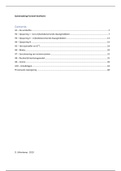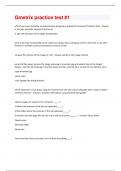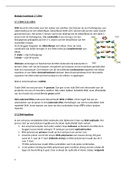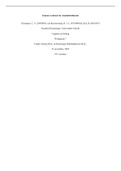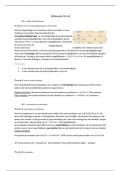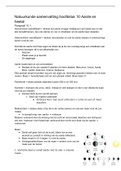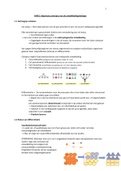Lecture 1
What is microeconomics?
Microeconomics has two areas:
o Analyzing the behavior of individuals and firms
o Explaining market structures and price setting
Microeconomics uses models based on ‘rationality’
Models are expressed by mathematical formulas
o Advantage: unambiguous
o Disadvantage: limited, complex
Model is ‘’locally’’ valid
Model can only be used for its specific purpose
What is an economic model?
Model is a simplified representation of real life
Trade-off between applicability and manageability
Example 1: firms have the impression that sickness absenteeism of workers is sometimes
longer than necessary
o Sick workers continue to receive salary
o Expensive for firms
o No incentive to start working soon
o At some moment a certificate from doctors confirming the sickness is required
Model prediction is that requirement of doctor’s certificate reduces the length of sickness
absenteeism
Swedish experiment:
o Born on even day: doctor certificate on 15 th day (treatment group)
o Born on odd day: doctor certificate on 8 th day (control group)
Hartman, Hesselius & Johansson (2013)
o Sick workers recover faster if a doctor’s certificate is required earlier
o But the additional costs for doctors to write certificates are higher than the reduced
salary payments to sick workers during their absenteeism
Sometimes a model is simple logic reasoning
Often mathematical formulas are used to build the model
Why models?
Goal of models is to explain or predict the change
Who uses economic models?
o CPB, ECB, AFM, ING, consultancy firms, ministries
Demand, supply and equilibrium
Equilibrium demand = supply
Supply depends on:
o Production technology
o Costs of inputs
o Market price
Demand depends on
o Preferences of consumers
, o Income of consumers
o Market price
o Prices of other goods
Prices cause that markets clear
o Supply > demand price goes down
o Demand > supply price goes up
Preferences
Consumers buy bundle of goods
Allocating scarce resources: size of the bundle is limited by the budget
Budget is used to:
o Buy consumer goods
o Save
o Enjoy leisure (labor supply decision)
Consumers make choice for bundle of goods on rationality
Maximize utility
Preference decides ‘amount of’ happiness (utility) a consumer derives from a bundle of
goods
Preferences differ between consumers
Assumptions:
o Completeness = consider a bundle A and bundle B, consumer either has preference
bundle A or bundle B or is indifferent. It rules out the ‘I don’t know’.
o Transitivity = If a consumer prefers bundle A over bundle B and bundle B over bundle
C, then consumer preferences bundle A over bundle C
o More is better = if bundle A contains for all goods at least the same amount as
bundle B and for at least one good more, then a consumer prefers bundle A over
bundle B
Indifference curve
A consumer who has the same preference for two bundles, is indifferent between these to
bundles
Indifferent curve = collection of all bundles of goods for which the consumer is indifferent
Economists use utility to describe the valuation of a bundle to a consumer
All bundles on a indifference curve have the same utility
Properties of indifference curve
o Downward sloping always
o Indifference curves can never cross
o Further away from the origin implies a higher utility
o Each bundle belongs to an indifference curve
Marginal rate of substitution
Indifference curve is downward sloping
So, reducing the amount of good X van often be compensated by increasing the amount of
good Y
Marginal rate of substitution: extent to which goods can be trated against each other
without affecting utility
o MRS = delta qy / delta qx
, MRS is the derivative of the indifference curve
Indifference curves of perfect substitutes (MRS = c)
Indifferent curves of perfect complements (MRS = 0 or MRS = infinity) car and gasoline
Lecture 2
Utility
Preferences are summarized in a utility function
Gives a numerical value to a bundle of goods
Utility is an ordinal measure
o Magnitude of utility is not relevant, only the (relative) ranking of bundles is
important
It is unimportant if utility of first bundle is 100 and second is 1 or first is 51 and second is 50
The only thing that is important is that the one bundle has a higher utility then the other
The utility function = U(qx,qy)
If a consumer prefers a bundle U(qx,qy) over a bundle U(qx’,qy’) then: U(qx,qy) > U(qx’,qy’)
o Qx’ and qy’ = different quantity
If a consumer is indifferent between bundles qx,qy and qx’,qy’, then: U(qx,qy) = U(qx’,qy’)
Indifference curves: all bundles (qx,qy) for which U(qx,qy) = U with a bar above
A utility function must satisfy the assumptions ono preferences
Completeness: utility function assigns a value to each bundle of goods
Transitivity: if U(qx,qy) > U(qx’,qy’) and U(qx’,qy’) > U(qx’’,qy’’) than U(qx,qy) > U(qx’’,qy’’)
More is better: if qx > qx’ and qy > qy’ then U(qx,qy) > U(qx’,qy’)
Marginal utility describes how much utility increases if the amount of a good in the bundle
increases with one
∂U (qx , q ¯ y)
Marginal utility (of good X) = Mux = >0
∂ qx
More is better implies that marginal utility cannot be negative
q¯y implies that the amount of good Y stays constant
Marginal rate of substitution
How many additional units of good Y are required to replace one unit of good Y?
∆qy is the change in the quantity of good Y
Changing the bundle, while keeping utility constant: ∆U = ∆qyMUy + ∆qxMUx = 0
Then the marginal rate of substitution follows: MRS = − ∆qy/ ∆qx = MUx /MUy
When MRS is small, only a few additional goods of Y are necessary to replace one unit of
good X, the marginal of good X is low compared to the marginal utility of good Y
Budget
Limited budget: constraint on the amount of consumption
Let B be the budget of the consumer for coffee and cookies
Qx is number of latte macchiato, qy is amount of chocolate chip cookies
pxqx + pyqy ≤ B
Opportunity set: All bundles (qx,qy) that can be bought with the budget
, 1 Px
Budget line: Pxqx + Pyqy = B ⇒ qy = B− qx
Py Py
Marginal rate of transformation: how much the consumer should sell of good Y to be able to
buy one additional unit of good X within the same budget
MRT = − ∆qy /∆qx = px / py
MRT determines the slope of the budget line
MRT does not change if the budget increases, only the opportunity set expands
MRT changes if the price of one good changes
Optimal bundle
Utility maximization within restrictions: pxqx + pyqy ≤ B
The bundle of goods is optimal if:
o The bundle lies on the budget line: pxqx + pyqy = B
o The marginal rate of substitution equals the marginal rate of transformation:
MRS = Mux / MUy = px / py = MRT
If the additional utility differs you can trade goods in your bundle to increase utility
Therefore, MRS = MRT (and it does not matter how you spend an additional euro)
Corner solutions
This gives the interior solution does not take into account of the restrictions that qx ≥ 0
and qy ≥ 0
Possibility of a corner solution, better to only buy one good
For example, qx = 0 and qy = B / py
When qx = 0 MRS is not MRT
Corner solution when indifference curves are relatively ‘flat’
But also in case of non-convex indifference curves
If MRS = MRT, then qx ≥ 0 en qy ≥ 0 but solution is not optimal
Concave indifference curves always give corner solutions
But they are unlikely
Consumer has a strong preference for only a homogenous bundle of goods instead of a
differentiated bundle
Compare outcome of maximization of utility with corner solutions
The optimal bundle can also be determined using the Lagrange multiplier method:
o L(qx, qy, λ) = U(qx, qy) − λ(pxqx + pyqy − B)
o The Lagrange method finds an optimum if the Lagrange function is convex (when
concave it finds a minimum).
Determining the optimal bundle
o Determine bundle with MRS = MRT
o Compare utility in corner solutions with utility when MRS = MRT
What is microeconomics?
Microeconomics has two areas:
o Analyzing the behavior of individuals and firms
o Explaining market structures and price setting
Microeconomics uses models based on ‘rationality’
Models are expressed by mathematical formulas
o Advantage: unambiguous
o Disadvantage: limited, complex
Model is ‘’locally’’ valid
Model can only be used for its specific purpose
What is an economic model?
Model is a simplified representation of real life
Trade-off between applicability and manageability
Example 1: firms have the impression that sickness absenteeism of workers is sometimes
longer than necessary
o Sick workers continue to receive salary
o Expensive for firms
o No incentive to start working soon
o At some moment a certificate from doctors confirming the sickness is required
Model prediction is that requirement of doctor’s certificate reduces the length of sickness
absenteeism
Swedish experiment:
o Born on even day: doctor certificate on 15 th day (treatment group)
o Born on odd day: doctor certificate on 8 th day (control group)
Hartman, Hesselius & Johansson (2013)
o Sick workers recover faster if a doctor’s certificate is required earlier
o But the additional costs for doctors to write certificates are higher than the reduced
salary payments to sick workers during their absenteeism
Sometimes a model is simple logic reasoning
Often mathematical formulas are used to build the model
Why models?
Goal of models is to explain or predict the change
Who uses economic models?
o CPB, ECB, AFM, ING, consultancy firms, ministries
Demand, supply and equilibrium
Equilibrium demand = supply
Supply depends on:
o Production technology
o Costs of inputs
o Market price
Demand depends on
o Preferences of consumers
, o Income of consumers
o Market price
o Prices of other goods
Prices cause that markets clear
o Supply > demand price goes down
o Demand > supply price goes up
Preferences
Consumers buy bundle of goods
Allocating scarce resources: size of the bundle is limited by the budget
Budget is used to:
o Buy consumer goods
o Save
o Enjoy leisure (labor supply decision)
Consumers make choice for bundle of goods on rationality
Maximize utility
Preference decides ‘amount of’ happiness (utility) a consumer derives from a bundle of
goods
Preferences differ between consumers
Assumptions:
o Completeness = consider a bundle A and bundle B, consumer either has preference
bundle A or bundle B or is indifferent. It rules out the ‘I don’t know’.
o Transitivity = If a consumer prefers bundle A over bundle B and bundle B over bundle
C, then consumer preferences bundle A over bundle C
o More is better = if bundle A contains for all goods at least the same amount as
bundle B and for at least one good more, then a consumer prefers bundle A over
bundle B
Indifference curve
A consumer who has the same preference for two bundles, is indifferent between these to
bundles
Indifferent curve = collection of all bundles of goods for which the consumer is indifferent
Economists use utility to describe the valuation of a bundle to a consumer
All bundles on a indifference curve have the same utility
Properties of indifference curve
o Downward sloping always
o Indifference curves can never cross
o Further away from the origin implies a higher utility
o Each bundle belongs to an indifference curve
Marginal rate of substitution
Indifference curve is downward sloping
So, reducing the amount of good X van often be compensated by increasing the amount of
good Y
Marginal rate of substitution: extent to which goods can be trated against each other
without affecting utility
o MRS = delta qy / delta qx
, MRS is the derivative of the indifference curve
Indifference curves of perfect substitutes (MRS = c)
Indifferent curves of perfect complements (MRS = 0 or MRS = infinity) car and gasoline
Lecture 2
Utility
Preferences are summarized in a utility function
Gives a numerical value to a bundle of goods
Utility is an ordinal measure
o Magnitude of utility is not relevant, only the (relative) ranking of bundles is
important
It is unimportant if utility of first bundle is 100 and second is 1 or first is 51 and second is 50
The only thing that is important is that the one bundle has a higher utility then the other
The utility function = U(qx,qy)
If a consumer prefers a bundle U(qx,qy) over a bundle U(qx’,qy’) then: U(qx,qy) > U(qx’,qy’)
o Qx’ and qy’ = different quantity
If a consumer is indifferent between bundles qx,qy and qx’,qy’, then: U(qx,qy) = U(qx’,qy’)
Indifference curves: all bundles (qx,qy) for which U(qx,qy) = U with a bar above
A utility function must satisfy the assumptions ono preferences
Completeness: utility function assigns a value to each bundle of goods
Transitivity: if U(qx,qy) > U(qx’,qy’) and U(qx’,qy’) > U(qx’’,qy’’) than U(qx,qy) > U(qx’’,qy’’)
More is better: if qx > qx’ and qy > qy’ then U(qx,qy) > U(qx’,qy’)
Marginal utility describes how much utility increases if the amount of a good in the bundle
increases with one
∂U (qx , q ¯ y)
Marginal utility (of good X) = Mux = >0
∂ qx
More is better implies that marginal utility cannot be negative
q¯y implies that the amount of good Y stays constant
Marginal rate of substitution
How many additional units of good Y are required to replace one unit of good Y?
∆qy is the change in the quantity of good Y
Changing the bundle, while keeping utility constant: ∆U = ∆qyMUy + ∆qxMUx = 0
Then the marginal rate of substitution follows: MRS = − ∆qy/ ∆qx = MUx /MUy
When MRS is small, only a few additional goods of Y are necessary to replace one unit of
good X, the marginal of good X is low compared to the marginal utility of good Y
Budget
Limited budget: constraint on the amount of consumption
Let B be the budget of the consumer for coffee and cookies
Qx is number of latte macchiato, qy is amount of chocolate chip cookies
pxqx + pyqy ≤ B
Opportunity set: All bundles (qx,qy) that can be bought with the budget
, 1 Px
Budget line: Pxqx + Pyqy = B ⇒ qy = B− qx
Py Py
Marginal rate of transformation: how much the consumer should sell of good Y to be able to
buy one additional unit of good X within the same budget
MRT = − ∆qy /∆qx = px / py
MRT determines the slope of the budget line
MRT does not change if the budget increases, only the opportunity set expands
MRT changes if the price of one good changes
Optimal bundle
Utility maximization within restrictions: pxqx + pyqy ≤ B
The bundle of goods is optimal if:
o The bundle lies on the budget line: pxqx + pyqy = B
o The marginal rate of substitution equals the marginal rate of transformation:
MRS = Mux / MUy = px / py = MRT
If the additional utility differs you can trade goods in your bundle to increase utility
Therefore, MRS = MRT (and it does not matter how you spend an additional euro)
Corner solutions
This gives the interior solution does not take into account of the restrictions that qx ≥ 0
and qy ≥ 0
Possibility of a corner solution, better to only buy one good
For example, qx = 0 and qy = B / py
When qx = 0 MRS is not MRT
Corner solution when indifference curves are relatively ‘flat’
But also in case of non-convex indifference curves
If MRS = MRT, then qx ≥ 0 en qy ≥ 0 but solution is not optimal
Concave indifference curves always give corner solutions
But they are unlikely
Consumer has a strong preference for only a homogenous bundle of goods instead of a
differentiated bundle
Compare outcome of maximization of utility with corner solutions
The optimal bundle can also be determined using the Lagrange multiplier method:
o L(qx, qy, λ) = U(qx, qy) − λ(pxqx + pyqy − B)
o The Lagrange method finds an optimum if the Lagrange function is convex (when
concave it finds a minimum).
Determining the optimal bundle
o Determine bundle with MRS = MRT
o Compare utility in corner solutions with utility when MRS = MRT



